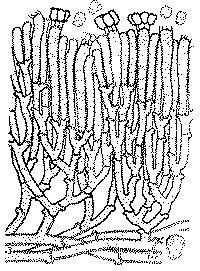|
 Tomentella scobinella Tomentella scobinella
BiostatusPresent in region - Indigenous. Endemic
Images (click to enlarge)
Caption: FIG. 3. Tomentella scobinella G.H.Cunn. Transverse section showing thick-walled basal
hyphae and thin-walled hyphae of the intermediate layer, x 500. Spore, x 1,000. |
Article: Cunningham, G.H. (1957). Thelephoraceae of New Zealand. Parts XII. The genera Thelephora and Tomentella. Transactions of the Royal Society of New Zealand 84(3): 479-487.
Description: Hymenophore annual, tufted-membranous, loosely attached, effused forming linear or
irregular areas 1-3 cm across; hymenial surface ranging from cinnamon to fuscus, or dingy
olivaceous, strongly granular; margin thinning out, fibrillose, concolorous, loosely attached.
Context fuscus, 120-200 µ thick, intermediate layer of loosely arranged mainly upright
hyphae, hyaline or tinted brown, basal layer scanty, composed of a few repent hyphae with
sparse septa and walls coloured chestnut-brown; generative hyphae 3-4 µ diameter in hyphae
of the intermediate layer, walls 0.2 µ thick, basal hyphae 5-6 µ diameter, walls to l µ thick,
septate, freely branched, with large clamp connexions. Hymenial layer to 60 µ deep, a close
palisade of hyaline basidia and paraphyses. Basidia subclavate, 30-50 x 6-8 µ, 2-4-spored;
sterigmata slightly arcuate, to 6 µ long. Paraphyses subclavate, or as often subfusiform,
shorter and narrower than the basidia. Spores subglobose, or oval, sinuate, 6-9 x 6-8 µ, walls
tinted brown, irregularly aculeate, 0.5 µ thick, spines to 0.5 µ long.
Habitat: HABITAT: Effused on decorticated decayed wood.
Distribution: DISTRIBUTION: New Zealand.
Notes: The species belongs to the section "Dimorphae" of Bourdot & Galzin (1928, 503), containing
plants with repent, thick-walled, sparsely septate, coloured basal hyphae and hyaline (or
tinted only) thin-walled mainly upright hyphae of the intermediate layer. It resembles T.
epiphylla in the granulose surface, but differs in that cordons are absent, spores are smaller
and context hyphae are much lighter in colour. Basidia, though long, are narrower than those
of other species placed in the section "Dimorphae".
|